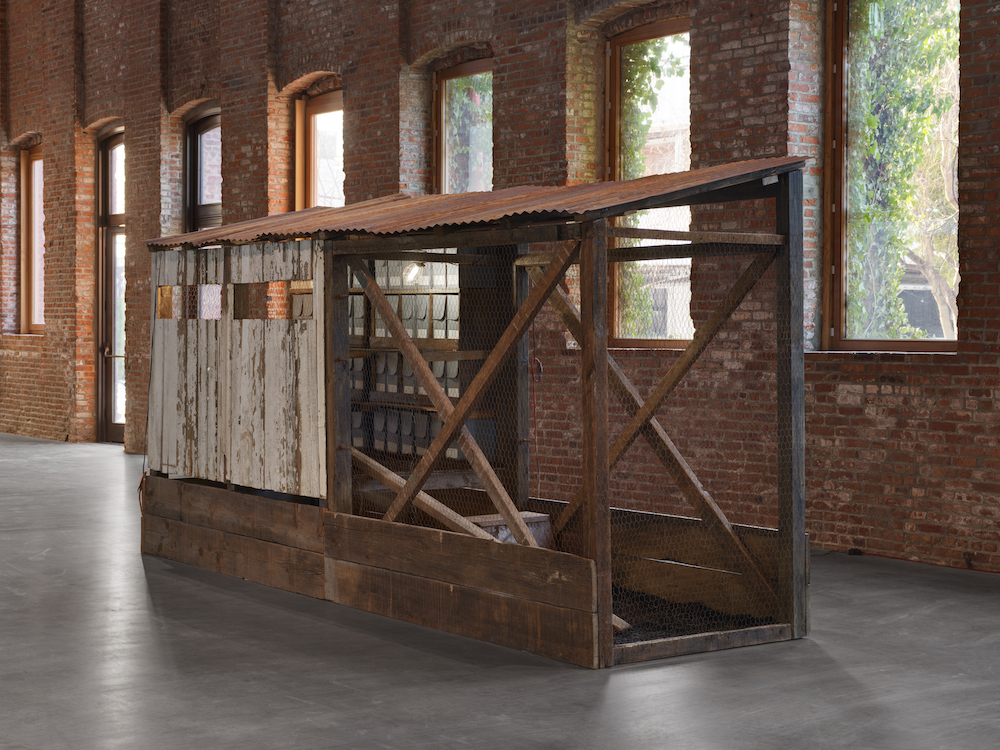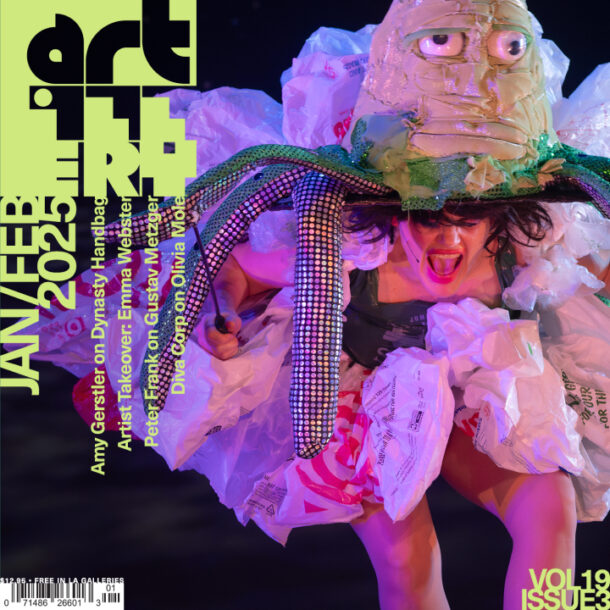In a small gallery of the California African American Museum, a wooden table hosting just short of two dozen drawings and a life-size sculptural replica of a chicken coop invoke a perplexing story about institutional partnerships in the contemporary arts. In “Shaper of God: Apple Valley Autonomy,” American Artist—known for their work across sculpture, video, and new media as well as the pointed legal change to their name—presents snapshots from their sprawling archival project. Initiated in 2021, and supported by artworld forces including The Hyundai Project, LACMA, Creative Capital, Kadist, REDCAT, and Getty, “Shaper of God” gathers research, archival materials, original artworks, and documentation that investigate the legacy of beloved American science fiction writer Octavia E. Butler, locating the Southern California landscape as a particular vector of Black experience that made its way into her otherworldly writing. “Shaper of God” includes three primary works—two sets of drawings, Octavia E. Butler Papers: mssOEB 1-9062: Local Documents (2025) and Octavia E. Butler Papers: mssOEB 1-9062: Maps (2025), and a sculpture Estella Butler’s Apple Valley Autonomy (2025).
Responding to archival materials that Butler left behind and her relationships with her mother, Octavia Margaret Guy, and grandmother, Estella Butler, American Artist traces the confluence that brought Black families to the Southern California desert in the post-war period. For Altadena-born American, having attended the same high school as Butler and lived within the locale where her fictions were sourced is clearly a site of potent influence. As with many of American Artist’s past works, but especially their conceptual work Looted (2020)—which temporarily removed all images of artwork in the Whitney Museum’s digital archive and replaced them with images of plywood—the exhibition tarries with institutional dynamics that place the legal owners of artwork, typically institutions, at odds with the public they claim to serve.

“American Artist | Shaper of God: Apple Valley Autonomy” (exhibition view). California African American Museum, August 19, 2025 – March 1, 2026; Photo: Elon Schoenholz.
At the core of the “Apple Valley Autonomy” chapter are significant, albeit hard-to-define, questions that circle around a common aspect of private archives—namely that reproductions of media from their holdings must be approved by the managers of the estate, who control how components from the archive make their way into the public sphere. Because so much of the work in “Shaper of God” is contingent on interactions with Butler’s private archive held at the Huntington Library, which houses more than 8,000 objects Butler posthumously donated after her passing in 2006, American Artist locates a productive tension in the control dynamics that shelter Butler’s legacy and potentially prevent the Black families who share her history from accessing documents that spell out the cultural milieu they collectively shaped.
In Estella Butler’s Apple Valley Autonomy (2025), the artist presents a “speculative recreation” of grandmother Butler’s chicken coop filled with archival boxes whose labels mirror the information systems that organize Butler’s papers. Enclosed within the coop and confined behind chicken wire, the literal content of the boxes has been sealed away. Viewers are left to contemplate the various connections that exist between, say, the homesteading activities that Butler’s family relied on to support themselves in the Southern California desert and the wide-ranging shells of her mental activity that stretch to imagined worlds and their real-life sources. While some of the labels present common archival infrastructure, such as “Correspondence,” “Medicine,” and “Politics,” others point toward charged intersections like “Disaster, The Environment, TV, Film, Radio, Theater.” This last category is perhaps the most important within the current milieu of the exhibition, which comes in the aftermath of the fires that decimated parts of historically Black Altadena earlier this year.
Such disasters are the bedrock of Butler’s fiction, with Parable of the Sower (1993)—where “Shaper of God” takes its name—being credited for its uncomfortably prophetic descriptions of California fires, civil unrest, and authoritarian rule. Her writings include significant critiques about the failures of institutional power and the gatekeeping mechanisms that societies turn to when resources become scarce, and when scarcity justifies desperation. Placing information behind wire, Artist suggests a faraway altar where the secrets of Butler’s life are kept, while American Artist’s drawings in Octavia E. Butler Papers: mssOEB 1-9062: Local Documents and Octavia E. Butler Papers: mssOEB 1-9062: Maps, outline a smuggling operation meant to bring them back into the public light.

American Artist, Estella Butler’s Apple Valley Autonomy, 2025 (detail). Photo: Dan Bradica. Collection of the California African American Museum. Courtesy of the artist and Pioneer Works.
Because the Huntington Library does not allow objects from the Butler collection to be reproduced without permission, American Artist turned to tracing. In both sets of drawings—made using archive-approved pink stationery and graphite pencils provided by the library—Artist produced hand-copies of excerpts of documents such as Butler’s application to be a tutor at the Los Angeles Public Library, her expired passport, and recreations of maps she drew while devising her fictions. The banal documents and amateur nature of Butler’s drawings filtered through American Artist’s discerning eye give their works on paper a unique, electrifying charge up close. The lifeblood of “Apple Valley Autonomy” teems with attention to detail and the subtle transfer of information via human hand, but the combination of “Shaper of God’s” seemingly endless production and its translation into a museum exhibition raises questions about its exact intentions.
Legibility at times seems like an afterthought in “Apple Valley Autonomy,” and it’s difficult to discern when that is purposeful or part of a forced error that recreates the same institutional gates that American Artist claims to subvert. It’s also unclear whether these legibility issues should even be attributed to the artist. The format used to display Octavia E. Butler Papers: mssOEB 1-9062: Local Documents and Octavia E. Butler Papers: mssOEB 1-9062: Maps exemplifies this ambiguity. The combination of sharp overhead lights and reflective glass intended to protect the work meant that it was nearly impossible to see without significant, obstructive glare. It’s possible these hotspots in the glass were meant to create an optical effect like the lens flare common in science fiction films. If so, the decision to disclose this aesthetic tactic was absent from the didactics circulated with the show. Instead, “Apple Valley Autonomy” seemed to manifest the same opacity that it claims to subvert while forcing viewers to defeatedly circle the display looking for (and not always finding) a position where they could see the drawings clearly. Similarly, while the tabletop positions the documents on one side and the maps on the other, it’s not entirely clear if the drawings on display represent the complete set of each collection or just selections from the archive.
This is disappointing because it undermines the sensitivity and care American Artist introduces in the show’s drawings. Awkward as it may sound, his tracings have an expert quality and dynamic range that make what would otherwise be a boring, mechanical task into a performative act of human witness. To American Artist’s credit, and to remove some of the responsibility from CAAM, it may just be the case that a single room-sized project space without sparse didactics cannot provide the contextual support necessary for what is clearly a massive undertaking. And while the museum did provide a copy of the compelling and useful “Shaper of God” catalogue at its front desk, it seems like keeping a few copies on hand in the exhibition space would have helped many first-time viewers understand that they’re looking at a pin-sized drop in Artist’s storied output.


